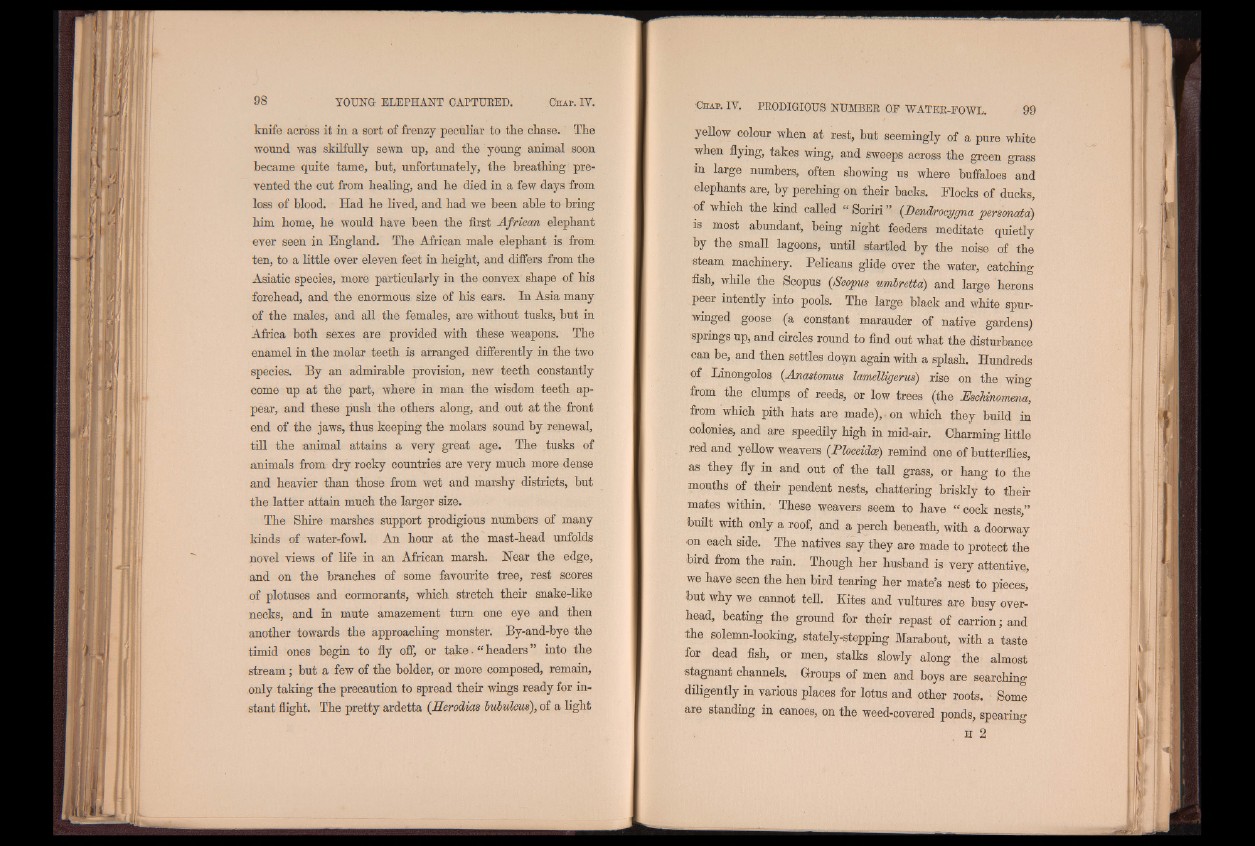
knife across it in a sort of frenzy peculiar to the chase. The
wound was skilfully sewn up, and the young animal soon
became quite tame, but, unfortunately, the breathing prevented
the cut from healing, and he died in a few days from
loss of blood. Had he lived, and had we been able to bring
him home, he would have been the first African elephant
ever seen in England. The African male elephant is from
ten, to a little over eleven feet in height, and differs from the
Asiatic species, more particularly in the convex shape of his
forehead, and the enormous size of his ears. In Asia many
of the males, and all the females, are without tusks, but in
Africa both sexes are provided with these weapons. The
enamel in the molar teeth is arranged differently in the two
species. By an admirable provision, new teeth constantly
come up at the part, where in man the wisdom teeth appear,
and these push the others along, and out at the front
end of the jaws, thus keeping the molars sound by renewal,
till the animal attains a very great age. The tusks of
animals from dry rocky countries are very much more dense
and heavier than those from wet and marshy districts, but
the latter attain much the larger size.
The Shire marshes support prodigious numbers of many
kinds of water-fowl. An hour at the mast-head unfolds
novel views of life in an African marsh. Near the edge,
and on the branches of some favourite tree, rest scores
of plotuses and cormorants, which stretch their snake-like
necks, and in mute amazement turn one eye and then
another towards the approaching monster. By-and-bye the
timid ones begin to fly off, or take | “ headers ” into the
stream; but a few of the bolder, or more composed, remain,
only taking the precaution to spread their wings ready for instant
flight. The pretty ardetta (Herodias bubulcus), of a light
yellow colour when at rest, but seemingly of a pure white
when flying, takes wing, and sweeps across the green grass
in large numbers, often showing us where buffaloes and
elephants are, by perching on their backs. Flocks of ducks,
of which the kind called “ Soriri ” (.Dendrocygna persmata)
is most abundant, being night feeders meditate quietly
by the small lagoons, until startled by the noise of the
steam machinery. Pelicans glide over the water, catching
fish, while the Scopus (Scopus umbretta) and large herons
peer intently into pools. The large black and white spur-
winged goose (a constant marauder of native gardens)
springs up, and circles round to find out what the disturbance
can be, and then settles down again with a splash. Hundreds
of Linongolos (Anastomus lamelligerus) rise on the wing
from the clumps of reeds, or low trees (the techinomena,
from which pith hats are made), -on which they build in
colonies, and are speedily high in mid-air. Charming little
red and yellow weavers (Phceidce) remind one of butterflies,
as they fly in and out of the tall grass, or hang to the
mouths of their pendent nests, chattering briskly to their
mates within. These weavers seem to have “ cock nests,”
built with only a roof, and a perch beneath, with a doorway
on each side. The natives say they are made to protect the
bird from the rain. Though her husband is very attentive,,
we have seen the hen bird tearing her mate’s nest to pieces,
but why we cannot tell. Kites and vultures are busy overhead,
beating the ground for their repast of carrion; and
the solemn-looking, stately-stepping Marabout, with a taste
for dead fish, or men, stalks slowly along the almost
stagnant channels. Groups of men and boys are searching
diligently in various places for lotus and other roots. Some
are standing in canoes, on the weed-covered ponds, spearing
H 2